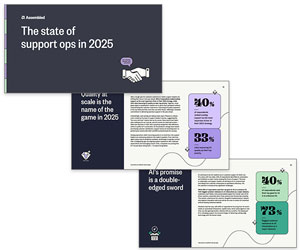Whitney Rose at Assembled offers key insights into navigating RFPs for workforce management software, highlighting common pitfalls and how to ensure you’re selecting the right vendor with confidence.
RFPs are the backbone of strategic vendor selection, cutting through the noise to ensure you pick the right partner with data-driven precision.
They force vendors to compete, driving down costs and boosting value. And by documenting every decision, they protect you from hidden risks and ensure you’re making the smartest, most transparent choice for your business.
But here’s the catch: some RFP requirements are much easier for vendors to check off than to actually deliver on.
We’ve seen it too many times – companies buy into a vendor’s promises, only to find themselves locked into a contract with a product that doesn’t perform and support that’s nowhere to be found.
A good RFP helps you define your needs, but to truly protect your investment, you need to know which questions to press on.
11 WFM RFP Red Flags (And How to Avoid Them)
After analyzing dozens of RFPs for workforce management (WFM) software and cross-referencing them with sales call data, we’ve unearthed 11 critical areas that often get glossed over – areas that tend to let users down once they’re actually using the software.
But we’re not just here to call them out; we’ll also show you exactly how to dig in and ensure you’re getting what you need. Let’s take a closer look at what you should double-click on to avoid costly mistakes.
1. So-Called “Seamless” Integrations
Vendors love to pitch their integrations as “seamless,” but that’s often marketing fluff. The reality is that getting your WFM to work flawlessly with your existing tech stack – HRIS, CRM, ticketing platforms, BI tools, and more – is no small feat.
These integrations are the lifeblood of your operations, and if they’re not rock solid, you’re looking at data inconsistencies, broken workflows, and costly fixes.
Advice: Don’t just check the box on integrations. Dig deep – ask about the validation process, the support structure if something goes wrong, and any hidden costs.
Make sure you understand what’s out of the box and what will require custom work. Without this scrutiny, your “seamless” experience could quickly turn into a data nightmare.
2. Spreadsheets that Just Won’t Die
Vendors love to claim their platform will eliminate the need for spreadsheets, but that’s often wishful thinking.
In reality, most WFM systems still rely on spreadsheets for those tricky edge cases where the core functionality falls short.
While spreadsheets offer flexibility for slicing and dicing data, relying on them too heavily is a sign that the WFM isn’t delivering on its promises.
Advice: Be cautious if a platform leans on exports to spreadsheets. If you find yourself constantly reverting to spreadsheets, it’s a red flag that the system isn’t meeting your needs.
Make sure the core features are robust and trustworthy – otherwise, you’ll be stuck doing double duty, questioning why you invested in the system at all.
3. Surface-Level Security Promises
Vendors love to parade their platform-level security features – SSO, encryption, SOC 2 compliance – but that’s just the tip of the iceberg.
The real challenge lies beneath the surface, in how the platform manages in-platform permissions and roles. These intricacies are often glossed over, leaving your WFM system vulnerable, especially when integrating with other tools.
If the WFM can’t protect the data it accesses or manage permissions effectively, you’re exposed to serious internal security risks that no compliance badge can fix.
Advice: Don’t be lulled into a false sense of security by buzzwords. Scrutinize how roles and permissions are managed within the platform, ensuring they align with your existing processes.
Also, dig into how the platform handles data security in the context of integrations. If these controls aren’t rock solid, your biggest security threat might be coming from within.
4. BPO Blind Spots
Most RFPs barely touch on the needs of managing outsourced agents (BPOs), leaving a critical gap in your workforce management strategy. Without proper visibility and data integration, transparency and accountability with your vendors can slip through the cracks, leading to chaos when things go wrong.
Advice: Don’t let BPO management be an afterthought. Ensure your RFP digs deep into BPO-specific features, focusing on seamless data flow and accurate mapping between systems. A platform that fails to provide clear visibility into your outsourced teams isn’t just a missed opportunity — it’s a recipe for disaster.
5. Omnichannel That’s Actually Multichannel
Vendors love to tout their omnichannel support, but future-proofing for new channels is often an afterthought.
You might end up with a platform that handles today’s channels just fine but stumbles as soon as something new emerges.
Advice: Don’t just accept the buzzwords. Ask how the platform adapts to new channels and scrutinize their track record of keeping up with industry changes. If they can’t prove it, you’re setting yourself up for serious gaps in your support strategy down the road.
Don’t let BPO management be an afterthought. Ensure your RFP digs deep into BPO-specific features, focusing on seamless data flow and accurate mapping between systems.
A platform that fails to provide clear visibility into your outsourced teams isn’t just a missed opportunity – it’s a recipe for disaster.
6. AI Hype vs. Reality
Vendors might paint a rosy picture of their AI capabilities, but often it’s more hype than substance. Without clear plans and robust security measures, these AI features can quickly turn into liabilities rather than assets.
Advice: Don’t get swept up by the buzz. Demand full transparency in their AI roadmaps and scrutinize how your data will be used within these AI functionalities.
Ensure they address both innovation and security – if they can’t provide solid answers, you might be stepping into risky territory that could compromise your operations.
7. The Reporting Mirage
Out-of-the-box reporting sounds like a dream come true, but just like those pesky spreadsheets that never seem to go away, the reality often falls short.
Sure, those dashboards might look impressive at first glance, but if they’re not delivering the insights you need when you need them, what’s the point?
And if key reports are locked away inside your WFM, getting everyone on the same page – from your team to top leadership – can feel like an uphill battle.
It’s crucial to make sure your in-app dashboards are pulling their weight, but don’t stop there. Integrating with your broader business intelligence (BI) tools is essential for a 360-degree view of your operations.
Advice: Don’t get dazzled by surface-level reports. Insist on dashboards and reports that give you actionable insights right out of the gate.
If you’re spending more time customizing than analyzing, you’re missing the mark. Make sure your WFM plays nicely with your BI tools, so you’re never in the dark about what’s happening across your support functions.
8. Lagging “Real-Time” Analytics
Real-time adherence tracking is critical for keeping operations smooth, but many platforms fall short when it matters most.
The data you see on the screen might not reflect what’s actually happening on the ground, leading to operational hiccups.
Advice: Don’t just take their word for it – test the platform’s real-time features during demos and ask for case studies that show how well they perform under pressure. If the platform falters, it could cost you in the long run when quick, accurate decisions are needed most.
9. A WFM That’s Trying To Do Too Much
Employee engagement features in WFMs might sound appealing, but they often fall flat because these platforms are built for data management, not morale boosting. Trying to do too much means the WFM excels at neither engagement nor its core functions.
Advice: Don’t fall for the one-size-fits-all trap. Choose a WFM that focuses on its strengths — forecasting, scheduling, and real-time management.
Let other, more specialized tools handle employee engagement to ensure you’re getting the best of both worlds.
10. Hidden Implementation Costs
Implementation timelines and costs are often wildly underestimated, leading to budget blowouts and frustrating delays. What seems like a straightforward setup can quickly spiral into a time-consuming and expensive ordeal.
Advice: Protect yourself from nasty surprises by demanding detailed, realistic timelines and a transparent breakdown of all associated costs.
Know exactly what you’re signing up for before the clock – and your budget – start ticking. Ensure the vendor outlines the steps and milestones, so you can manage expectations and avoid costly overruns.
11. Hard to Define Total Cost of Ownership
Vendors often downplay the total cost of ownership, conveniently glossing over hidden fees for training, data storage, and more.
What seems like a straightforward price tag can quickly balloon with unexpected expenses post-implementation.
Advice: Don’t be caught off guard – ask detailed questions about all possible costs upfront. From training and data storage to integration fees and support, get the full picture.
Prepare for these post-implementation expenses to avoid budget overruns and ensure a clear financial roadmap that aligns with your expectations.
This blog post has been re-published by kind permission of Assembled – View the Original Article
For more information about Assembled - visit the Assembled Website
Call Centre Helper is not responsible for the content of these guest blog posts. The opinions expressed in this article are those of the author, and do not necessarily reflect those of Call Centre Helper.
Author: Assembled
Reviewed by: Megan Jones
Published On: 10th Sep 2024 - Last modified: 23rd Oct 2024
Read more about - Guest Blogs, Assembled, Whitney Rose






 Assembled is a Support Operations platform that helps companies maintain exceptional customer experiences, no matter what lies ahead. Leading brands use Assembled's workforce and vendor management capabilities to make optimal staffing decisions, gain visibility into performance and productivity, and unlock new ways to serve evolving customer needs.
Assembled is a Support Operations platform that helps companies maintain exceptional customer experiences, no matter what lies ahead. Leading brands use Assembled's workforce and vendor management capabilities to make optimal staffing decisions, gain visibility into performance and productivity, and unlock new ways to serve evolving customer needs. 

































